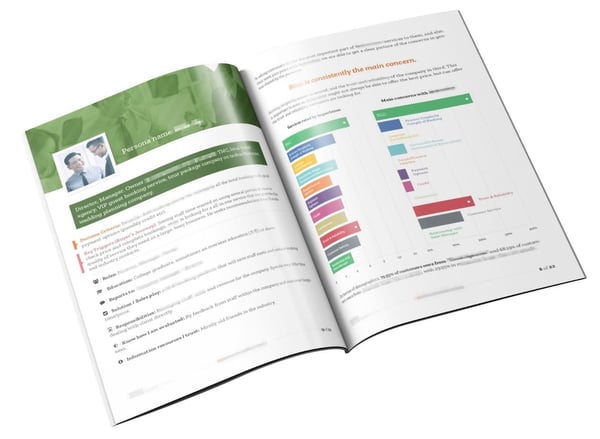Most business owners and marketers are likely aware that understanding your target market is vital to achieving success with your marketing strategy. You might have heard of the term "Buyer Persona", but do you really know what it means? Or more importantly, how to effectively create one that can transform your marketing campaigns?
In this blog post, we're going to delve into the topic of Buyer Personas. We will unwrap this concept, explain how important it is, and offer you a practical guide to crafting your own. Let's dive right in!
What is a Buyer Persona?

Buyer Personas represent your ideal customers, fictionalised profiles based on real data and market research. These profiles encompass the behaviours, needs, motivations, and goals of your potential customers. The more thorough and accurate these profiles are, the more effectively they can guide your product development, sales strategies, and marketing efforts.
Unlike a simple customer description (User Profile), a Buyer Persona not only includes demographic information such as age, gender, income, geographical location, and educational level, but more importantly, lists out all the customer's consumption motives and intentions that have a significant impact on their decision to make a purchase. Different customer groups have different characteristics, so you can establish more than one Buyer Persona.
Creating Effective Buyer Personas
Constructing Buyer Personas requires a blend of industry research, customer feedback, and market data. This process involves conducting surveys, interviewing customers, and analysing existing customer data. You can follow the nine steps below to gradually outline the appearance of ideal customers and establish a series of exclusive Buyer Personas:
Step 1: Build a Questionnaire
Refer to the 5 Rings of Buying Insight and design a questionnaire. This concept helps you understand:
- Priority Initiatives: What is unique about your product or service that makes consumers willing to buy?
- Success Factors: What goals do consumers expect your product or service to help them achieve?
- Perceived Barriers: What factors prevent your product or service from being considered by consumers?
- Buyer's Journey: How do your consumers implement their consumption choices?
- Decision Criteria: Why are your competitors preferred, and how do they affect consumer choices?
Step 2: Utilise Online Tools
Use online questionnaire survey tools to create and publish questionnaires.
Step 3: Connect with Customers
Search for the email addresses of all customers in your CRM system, send out the questionnaire and collect results.
Step 4: Dive Deeper with Interviews
From your CRM system, select 15 to 20 of your most valuable customers. Arrange interviews or phone calls with them. These one-on-one discussions will offer deeper insights and help you get a more nuanced understanding of your customer personas.
FAQ:
Roughly how long should your Buyer Persona interviews take?
The length of your Buyer Persona interviews can vary depending on the complexity of your market and the depth of information you're seeking. Typically, an effective Buyer Persona interview should take 20 minutes.
Speak to our CRM experts to ensure these conversations are comprehensive yet efficient, gleaning critical insights to shape a robust and effective marketing strategy. Remember, the goal is quality insights, not just time spent.
When is an appropriate time to conduct a buyer persona interview?
An appropriate time to conduct a buyer persona interview is during the initial stages of your marketing strategy development, as well as periodically throughout your campaign to ensure your personas remain accurate and relevant. Additionally, it's beneficial to conduct these interviews whenever there are significant changes in market trends, customer behaviour, or when launching a new product or service.
Step 5: Probe Deeper During Interviews
First ask the interviewee the questions in the questionnaire, and follow up questions as needed to understand their thoughts deeply.
Step 6: Record and Analyse Interviews
Remember to record the interview, which will help to note representative quotes later.
Step 7: Integrate and Analyse Data
Once you've collected all your data, it's time to analyse it. Look for trends or phenomena in the survey, and integrate this information into various customer profiles.
Step 8: Craft Detailed Buyer Personas
Finally, for each "ideal customer", create a profile that clearly explains their demographic information, psychological characteristics, and quotes from interviews. Each profile should give you a clear view of who your customer is and what they want, guiding your marketing strategies moving forward.
Advantages of Using Buyer Personas in Marketing

After fully understanding the Buyer Personas, the quality of product or service development, content marketing, or after-sales follow-up of a company will then significantly improve.
In fact, some businesses have achieved an additional 124% sales leads by creating buyer personas. Also, when companies update their websites according to buyer personas, the browsing experience for target users can be improved by 2 to 5 times.
The following case studies will help you better understand the advantages of effectively utilising Buyer Personas in your marketing:
1. Enhancing the Precision of Messaging
Instead of creating one-sided messaging that targets all consumers, businesses can deliver more precise marketing messaging to specific Buyer Personas, precisely tackling their pain points.
| Case study: A hotel booking platform, while entering a new market, adjusted its marketing messages according to the profiles of different Buyer Personas. They understood that travel agencies are dedicated to saving labour costs and achieving higher efficiency, while consumers hope to book hotels at the lowest prices. Therefore, they convey different messages to different Buyer Personas, framing their solutions in different perspectives. |
2. Ensuring Product or Service Quality
If companies incorporate customer feedback into Buyer Personas and ensure relevant departments are aware of them, they can continuously improve the quality of their products or services.
| Case study: A blockchain-powered app was collecting first-hand customer feedback while gathering Buyer Persona data, acquiring inspirations for improving their user interface and functionality. Some customers thought there were too many texts on the app interface, so they simplified the content and added more visuals to improve their user experience. |
3. Facilitating Smarketing Connection
"Smarketing" refers to the connection between sales and marketing departments, which is essential to increasing profitability by establishing common goals across the teams. Here, the Buyer Persona plays a crucial role. Different departments can refer to the same Buyer Personas to understand the business's direction and focus resources on identifying and nurturing the most valuable customer groups. This reduces costs and increases revenue in the long run.
| Case study: The marketing team of a marketing automation software keeps track of the resources the company invested in each buyer persona. With access to this data, the sales team adjusts their communication methods with different Buyer Personas, which promotes overall business efficiency. |
4. Tailoring Content Marketing
What topics customers are interested in, and what information they need at different stages of the consumer journey, should all be built on the Buyer Personas. For marketing teams, the marketing content they create, such as emails and social posts, and the timing of their release can be more targeted.
| Case study: When a foreign institution was recruiting locally, it refers to the local school calendar and understands the needs of students on different days of the week. With access to this information, they developed their editorial calendar, publishing the most suitable information to the most suitable audience at the most appropriate time. |
Utilising Your Buyer Personas
Once your Buyer Personas are developed, they become instrumental in guiding all aspects of your business. They inform your product development process, ensure your marketing messages hit the mark, and enable you to personalise your sales interactions. Aligning your business strategies with the insights gleaned from your personas can lead to increased customer satisfaction and, ultimately, sustainable business growth.
Developing Buyer Personas For China
There are three main steps to developing customer personas specific to China. These approaches involve creating personas from scratch, adapting existing personas with cultural information for Chinese customers, and validating and refining the personas over time.
Developing personas from scratch:
To start, you can choose to create Chinese customer personas entirely from the beginning, similar to how you would develop personas for Western markets. Although this method provides the most accurate and specific descriptions of Chinese customers, it requires substantial effort to gather customer data, conduct research, and utilise available resources.
The initial step in developing personas from scratch involves collecting quantitative data using methods such as web analytics, customer relationship management (CRM) systems, surveys, and social listening. However, relying solely on quantitative data may not be sufficient to create robust personas. It is also crucial to gather qualitative data through direct customer interviews, conversations with customer service and sales teams, and collaboration with different departments to gain a comprehensive understanding of your customers.
Adapting existing personas to China:
The second approach involves taking the personas that have been developed for other Western markets and making adjustments to tailor them specifically for the Chinese market. This method offers a relatively easier and faster way to create Chinese customer personas than starting from scratch.
To adapt existing Western personas for China, you can begin by reviewing the characteristics and behaviours of your current personas. Identify the aspects that may not align perfectly with the Chinese cultural context and business environment. For example, if your existing persona emphasises individualism and independence, you may need to consider how collectivism and group dynamics play a more significant role in the Chinese market.
Next, you can modify the persona by incorporating cultural information that is specific to Chinese customers. This could involve understanding Chinese values, preferences, social norms, and business practices. For instance, you might adjust the persona's priorities, motivations, and decision-making factors to reflect the importance of guanxi (building relationships) and face-saving in Chinese culture.
By making these adaptations, you can create a version of your Western persona that better resonates with Chinese customers. It is important to remember that while this approach offers a quicker solution, it may not capture all the nuances and intricacies of the Chinese market. Therefore, it is crucial to validate the adapted personas through the last step of customer research, feedback, and ongoing refinement.
Validating and refining personas:
The final step, regardless of the approach chosen, is crucial. It is to validate and refine the personas over time. This involves regularly gathering customer insights, analysing data, and incorporating new information to ensure the personas accurately represent the target audience in China. By continuously refining the personas, you can adapt and improve your marketing strategies and better meet the needs and preferences of Chinese customers.
Difficulties in developing buyer personas in China
If you are doing digital marketing in China, it might be particularly difficult to navigate. Here are some of the most common difficulties when it comes to creating a buyer persona for the Chinese market:
- Some companies believe their product and service are so good that they are for “everyone everywhere”, and that they do not need a Buyer Persona.
- Some non-China based companies think that China is no different to the western market or they tend to underestimate the complexity and uniqueness of the Chinese market.
- They also think as long as the translation of the product/services introduction on the website is fine, the content should be fine as well.
- Last but not least, they might also believe that China's internet ecosystem is not as robust as compared to the West, and the competition is not fierce.
What does a Buyer Persona document look like?
A Buyer Persona document should be a comprehensive profile of your ideal customer, including their demographics, goals, challenges, and pain points. It should also include quotes from customer interviews to accurately reflect their thoughts and feelings.
Below is am example of a Buyer Persona document, which can serve as a template for businesses to create their own.

Why Oxygen can help you
At Oxygen, we excel at enabling businesses to build a robust digital presence and extend their reach globally. As an official HubSpot Partner, we help facilitate your growth through the use of HubSpot's robust toolset. A pivotal part of this process involves helping businesses define their buyer personas. Our team is dedicated to assisting you in understanding your ideal customers - their demographics, psychographics, behaviours, motivations, and pain points.
Beyond the creation of these buyer personas, we ensure they are put to effective use across product development, marketing, and sales. Our commitment is to keep your business competitive, responsive to market dynamics, and attuned to customer needs, driving satisfaction and business growth.
Ready to take the next step in enhancing your customer relationship management strategy?
Speak with one of our marketing experts to find out how we can help.
 UAE/GCC
UAE/GCC International
International










